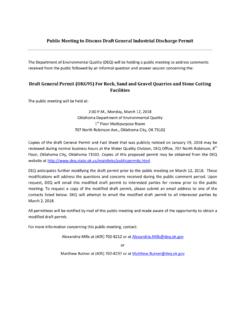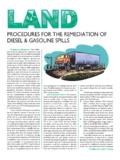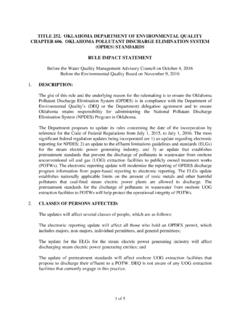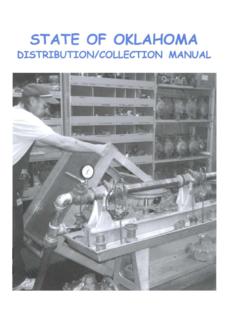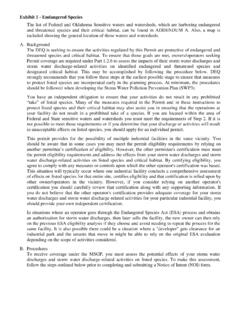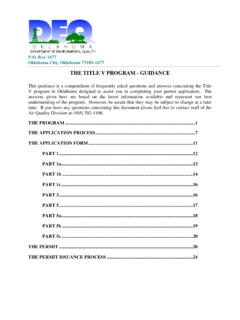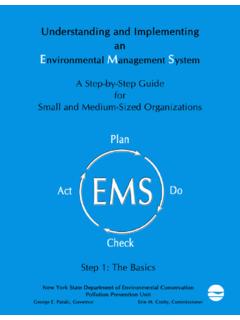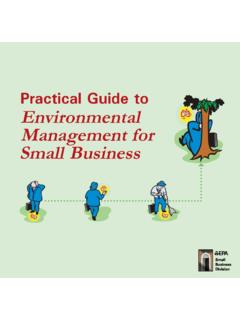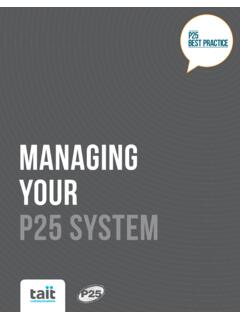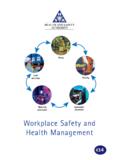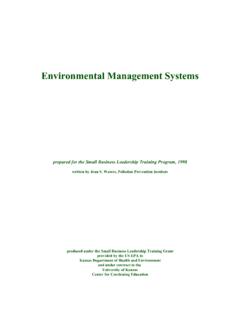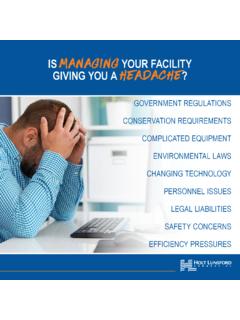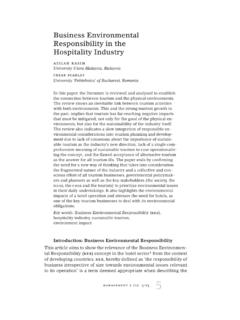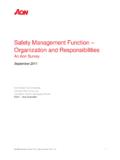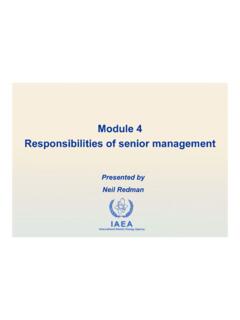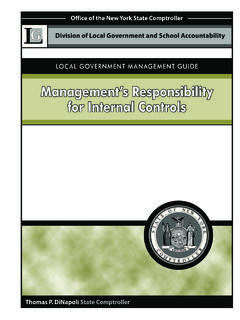Transcription of How to Inventory Your Waste for Environmental Compliance
1 How to Inventory your Wastefor Environmental ComplianceHow to Inventory your Wastefor Environmental ComplianceCustomer Service DivisionPollution Prevention ProgramAcknowledgementThis document was adapted from a publication created by the Pacific NorthwestPollution Prevention Resource Center (PPRC). The original publication owed much tothe input of the employees of the Environmental agencies in the Pacific Northwest(Alaska, Idaho, Washington and Oregon) and the support of USEPA Region Compliance and pollution prevention informational guide was created to providemulti-media Compliance and pollution prevention assistance, and to aid smallbusiness owners with questions concerning Environmental issues. This information isnot a comprehensive document covering every Environmental regulation that couldaffect a business.
2 It is the responsibility of the owner/operator to stay abreast ofchanges in Environmental regulations that govern his/her OF CONTENTSHow Can This Workbook Help You? .. 61. Creating your Inventory Lists .. 12 Hazardous/Solid Waste InventoryAir Emission Sources InventoryWater Pollution Sources Understanding Hazardous Waste .. 22 Determine if wastes are hazardous or non-hazardousQuantify monthly generation of hazardous wastesDetermine hazardous Waste generator statusIdentify requirements for being a hazardous Waste generator3. Understanding Air Emission Sources2 .. 32 Determine if products contain regulated chemicalsEstimate annual use of regulated chemicalsDetermine air emission source statusIdentify requirements for using regulated chemicals4. Understanding Water Pollution Sources.
3 46 Understand responsibilities and requirements for managing water pollution sources5. Emergency Planning & Community Right-to-Know (EPCRA) .. 52 Appendices: .. 61 APPENDIX A: Internet Resources .. 62 APPENDIX B: Weekly Facility Inspection List .. 64 APPENDIX C: List of Hazardous Air Pollutants .. 65 APPENDIX D: EPCRA .. 68 APPENDIX E: Other Federal and State 766 Aerosol cans Parts washer sludge/solvent Cleaners Process water Cleanup absorbents (floor dry) Solvent still sludge Contaminated antifreeze Spent hydraulic oil Contaminated fuel Spent processing chemicals and rinsewater Contaminated used oil Surface coating materials Dirty shop towels Tramp oils Vehicle maintenance wastes Hazardous Air Pollutants Volatile organic compound (VOC) air emissions Packaging Waste Waste acids (hydrochloric, nitric, sulfuric, chromic, etc.)
4 Paint-related wastes (sludge, strippers, thinners, etc.) Waste adhesives Paint chips and sandblast media Waste batteries/battery fluids Waste solventHow Can This Workbook Help You?This workbook will help you learn how to:Lower your operating costsProvide safer conditions for workersReduce costs of Environmental complianceProtect the environmentReduce exposure to future liabilityImprove your company s public guide is divided intoeasy-to-follow Sections writtento help you better identify andcalculate the types andquantities of wastes generatedand emitted from your shop,Typical Wastes Encountered in ManufacturingRegulated wastes andemissions from manufacturingoperations can include liquidand solid hazardouswastes, air emissions,and alsoproduce non-hazardous solidwaste. Figure 1 shows typicalwastes from a manufacturingenvironment.
5 Look around yourbusiness and consider how thisfigure applies to 1-1b will help guideyou in identifying commonmanufacturing the environmentalregulations associated withthese wastes, and identifyopportunities to reduce oreliminate the generation 1 Typical Wastes Encountered in Manufacturing7 PRE-FABRICATIONFABRICATIONPOST-FABRICATI ONMAINTENANCEC utting fluidsWaste solventDegreasing solventsAntifreezeSolvent cleanersWelding antisplatterCleaning wastewaterWaste oilAbsorptive materialWelds surfaceAlkaline cleanersSpent solvent fromfloor dry, vermiculite)preparation (solvents)parts washersContaminated shop towelsEtching acidsBrake cleanersMetal swarfSolvent saturated ragsCarburetor cleanersTramp oilSurface coatings (paints, primers)Spent coolantBiocides/fungicides/Spent spray gun cleanersSpent cutting fluidbactericidesExtreme pressurePaint strippersFluid absorbentsadditivesSolvent distillation sludgeBatteriesTypical Wastes Encountered in the Metal Fabrication ProcessRegulated wastes andemissions from metalfabrication operations caninclude liquid and solidhazardous wastes, airemissions, and also produce non-hazardous solid Waste (suchas scrap metal).
6 These wastescan be associated with thefour general process steps: pre-fabrication, fabrication post-fabrication and 1a shows these foursteps and the typical wastesthat each step produces. Lookaround your business andconsider how this figure appliesto Wastes Encountered in the Printing ProcessRegulated wastes andemissions from commercialprinting operations caninclude liquid and solidhazardous wastes, airemissions, and also produce non-hazardous solid Waste (suchas scrap paper). These wastescan be associated with thefour general process steps:imaging, pre-press, press(including the make-ready stepfor lithographic printing), andpost-press. Figure 1b showsthese four steps and the typicalwastes that each step around your business andconsider how this figure appliesto 1a Typical Wastes Encountered in the Metal Fabrication Process8 IMAGINGPRE-PRESSPRESSPOST-PRESSE xposed and Waste filmDamaged or unusable platesEmpty ink containersPaper scrapScrap paperEmpty chemical containersUnacceptable printsGlue/adhesive wasteAerosol cansSpent processing chemicalVolatile organic compoundPackaging wasteand rinsewater(VOC)
7 Air emissionsSpent developerWaste ink/solventSpent fixerSoiled rages andpaper wipesUsed rinsewaterUnusable platesDirty shop towelsSpent fountain solutionsEmpty chemical containersUsed or damaged blanketsWaste proofsSpent equipment oilCreating a list of all of the Waste streams at your facility makes good businesssense. An Inventory of wastes will: Allow you to distinguish between wastes that are considered hazardous, air emissionsor water pollutants and wastes that can be recycled or landfilled. Help you make changes in your operating practices as regulations change. Since youwill know what wastes are considered hazardous and the quantities of these wastes,the impacts of regulations will be easy to identify. Guide you on controlling costs associated with meeting your 1b Typical Wastes Encountered in the Printing Process9 ChecklistThe sections listed below should bechecked off after you have completed thesuggested action in that particularsection.
8 Once this list is completelychecked off you have successfullyprogressed through the Waste inventoryprocess and have gained a better awarenessof your Waste streams and how those wastesare regulated. You will have the knowledgeto begin to eliminate or reduce these wastestreams by implementing pollutionprevention Creating Waste Inventory Lists___Hazardous/solid Waste inventory___Air emission sources inventory___Water pollution sources inventory2. Understanding Hazardous Wastes___Determine if wastes are hazardous, recyclable or landfillable___Quantify monthly generation of hazardous wastes___Determine hazardous Waste generator status___Identify requirements for being a hazardous Waste generator3. Understanding Air Emission Sources___Determine if products contain hazardous air pollutants and other air toxics___Estimate annual emissions of criteria pollutants and/or hazardous air pollutants___Determine air emission source status (major or area source)___Determine if you are subject to any specific federal air quality standard4.
9 Understanding Water Pollution Sources___Understand responsibilities and requirements for having water pollution sources5. Emergency Planning & Community Right-to-Know (EPCRA)___Reporting requirements___Steps to ComplianceSection 1: Creating YourInventory Lists121: Creating Waste Inventory ListsFill out the worksheets toinventory your hazardous andsolid wastes, air emissions andwater pollution sources. Eachworksheet has differentinstructions, so be sure yourecord hazardous and solidwastes on the Hazardous/SolidWaste Inventory worksheet;record air emission sources onthe Air Emission SourcesInventory worksheet; andrecord water wastes on theThis section will help you develop your own Inventory list ofhazardous Waste streams, air emission sources and water wastesfor the processes in your facility.
10 Water Pollution SourcesInventory you use a computer, youmay prefer to create your owntables or spreadsheets andenter this informationelectronically to makecalculating and manipulating ofthe data a MSDS for Each Waste on your Inventory ListsThe Occupational Safety andHealth Administration s (OSHA)Hazard Communication(Worker-Right-to-Know) rulerequires all businesses tomaintain an up-to-datecollection of Material SafetyData Sheets (MSDSs) for allproducts used onsite that mayaffect employee safety orhealth. You should already bemaintaining a full set ofrelevant MSDSs in a file that isaccessible to all employees atyour MSDSs will be used tocomplete the steps in thisworkbook. You will needto have a copy of theMSDS for eachproduct that is partof a Waste you list on theinventory worksheets.
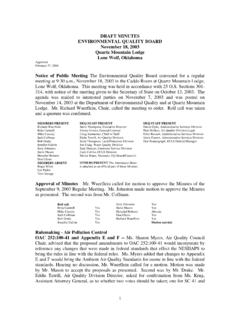
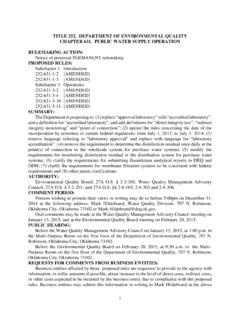
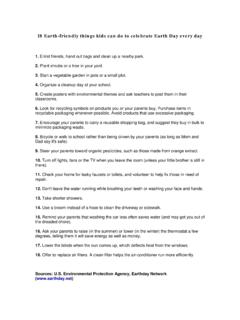
![[NOTICE OF RULEMAKING INTENT] - Welcome to …](/cache/preview/0/e/b/1/6/4/5/2/thumb-0eb16452057ea1b264c252307d7f8015.jpg)
